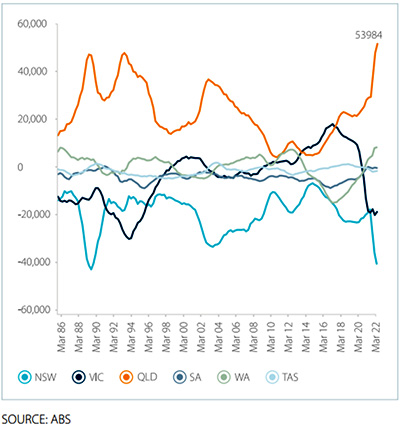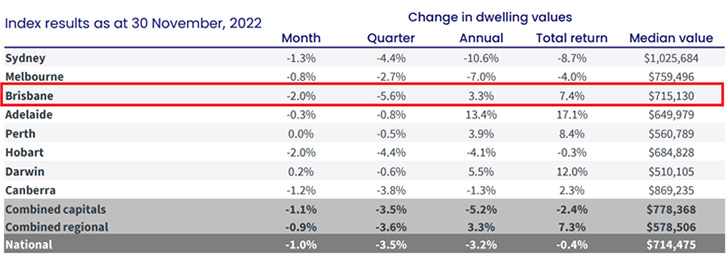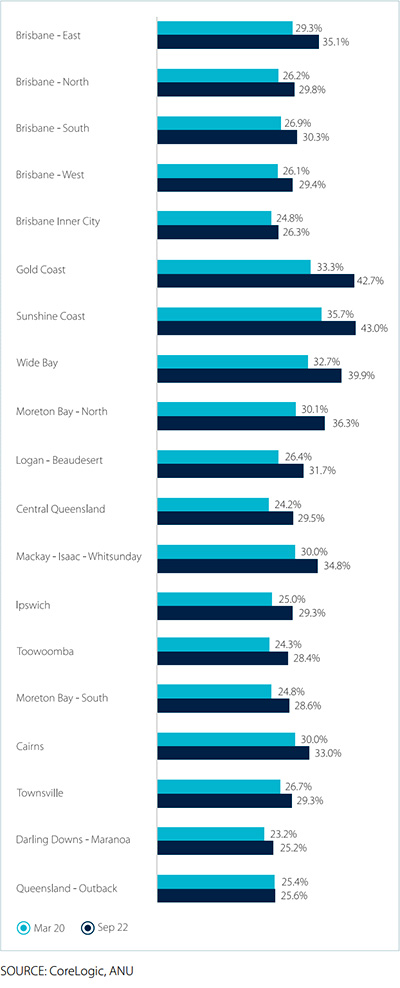Migration stemming Brisbane property price falls
Brisbane's property prices continue to fall but the relatively strong performance of the unit market, together with high migration levels, has eased the pace of decline.
Interstate migrants pouring into Queensland are propping up property prices that might otherwise be tumbling rapidly in the face of rising interest rates and cost of living pressures.
Encouraged by Brisbane’s relative real estate affordability compared to Sydney and Melbourne, and strong jobs growth, people from New South Wales and Victoria continue to pour across the border to resettle.
Data from the Australian Bureau of Statistics relating to internal migration showed that 47.8 per cent of interstate migration to Queensland was from New South Wales and a further 27.9 per cent was from Victoria.
Around 92,000 people are calling Queensland their new home each year, a population growth rate of 1.8 per cent.
Many are drawn by the strong employment prospects and lifestyle advantages if they are able to work from home.
The annual jobs growth figure for Queensland was 4 per cent in September 2022, which is well above the 20-year average of 2.4 per cent.
Rolling annual interstate migration

Despite this migration influx, property prices have continued to fall even if the pace of decline is easing.
Brisbane houses appreciated by 33.1 per cent since the start of Covid and Brisbane units have grown 28.9 per cent in that time.
The market has since segmented in Brisbane, particularly over the last few months, with unit values remaining relatively resilient compared to house values.
Throughout November, the median value of dwellings in Brisbane declined 2.0 per cent, according to CoreLogic. This is comparable to last month.
The annual capital growth is still 3.3 per cent for Brisbane dwellings. The median value of a dwelling in Brisbane is now $715,130.
The relative affordability of housing across Brisbane compared to Sydney and Melbourne has been described as one potential attraction.
The latest CoreLogic data shows the median house price in Sydney is $1,243,126 and in Melbourne $915,005. The median house price in Brisbane is just $798,552.
There is conflicting data that suggests the recent Brisbane property prices falls are less severe.
Proptrack data reports a much more modest change in property values during November of just 0.04 per cent and a higher annual growth rate of 4.7 per cent.
Brisbane units outperforming houses
During November, the median value for units across Greater Brisbane slipped 0.5%, as reported by CoreLogic. Houses, however, fell at a more noticeable 2.2 per cent in each of the past two months.
For units, it represented an improvement on the previous month when values declined 0.9%. Over the last 12 months Brisbane units have grown 8.9 per cent, significantly better than the 2.2 per cent capital growth for houses over a year.
The median value for a unit in Brisbane is now $492,481.

Brisbane rents rising the fastest
Proportion of income required to service new rents (Qld SA4 submarkets, dwellings)

Brisbane has had the highest annual change in house rents (up 13.4 per cent) in the country, and the second highest change in annual unit rents (up 14.3 per cent).
Rentals are hard to come by, with the vacancy rate in Brisbane, according to SQM Research, currently at 0.8 per cent.
Rental affordability is becoming a concern throughout Brisbane in lower income households.
Due to the recent sharp increase in rental prices, the portion of income required to service a new lease on a house hit a record high in September 2022 at 32.1 per cent.
It is important to note that not all submarkets are becoming unaffordable, as this is dependent on the incomes of the demographic group in a particular location.
With little being done to expand rental supply in the short term, rents in Brisbane will continue to rise, especially if migration levels remain high.
Brisbane’s prospects for 2023
The uncertainty in relation to buying in a higher interest rate environment appears to be easing for Brisbane buyers.
There is an expectation that buyers who have been taking a wait and see approach will re-enter the market once interest rates stabilise early in 2023.
In such a tight supply market, especially for quality properties, unless there is a reason to sell, a lot of sellers are also taking a wait and see approach.
There is no evidence of the large scale forced selling that would be necessary to see a large spike in supply, which could cause further price falls in some areas.


















